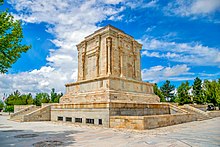Tus, Iran
Ancient city in Iran From Wikipedia, the free encyclopedia
Tus (Persian: توس, romanized: Ṭūs) was an ancient city in Khorasan near the modern city of Mashhad, Razavi Khorasan province, Iran. To the ancient Greeks, it was known as Susia (Ancient Greek: Σούσια). It was also known as Tusa.[1] The area now known as Tus was divided into four cities, Tabran, Radakan, Noan and Teroid, which in combination formed largest city in the region in the fifth century.[citation needed]
توس | |
 Ferdowsi's tomb in Tus | |
| Location | Razavi Khorasan Province, Iran |
|---|---|
| Coordinates | 36°28′45.0″N 59°30′35.0″E |
| Type | Settlement |
| Site notes | |
| Condition | In ruins |


History
According to legend Tous son of Nowzar founded the city of Tous in the province of Khorassan next to today's city of Mashhad. It is said that the city of Tous was the capital of Parthia and the residence of King Vishtaspa, who was the first convert to Zoroastianism.[2] It was captured by Alexander the Great in 330 BCE, and became a key waypoint on the Silk Road.
Tus was taken by the Umayyad caliph Abd al-Malik and remained under Umayyad control until 747, when a subordinate of Abu Muslim Khorasani defeated the Umayyad governor during the Abbasid Revolution.[3] In 809, the Abbasid Caliph Harun al-Rashid fell ill and died in Tus, on his way to solve the unrest in Khorasan.[4] His grave is located in the region.[5]
In 1220, Tus was sacked by the Mongol general, Subutai, and a year later Tolui would kill most of its populace,[6] and destroying the tomb of Caliph Harun al-Rashid in the process.[7] Decades later, Tus would be rebuilt under the governorship of Kuerguez.[7]
The most famous person who has emerged from that area is the poet Ferdowsi, author of the Persian epic Shahnameh, whose mausoleum, built in 1934 in time for the millennium of his birth, dominates the town. Other notable residents of Tus include the theologian, jurist, philosopher and mystic al-Ghazali; early polymath Jābir ibn Hayyān; the poet Asadi Tusi; the powerful Seljuk vizier Nizam al-Mulk; the medieval polymath Nasir al-Din al-Tusi; the prominent Usooli mujtahid (Twelver-Shi'a law interpreter) Shaykh Tusi; and the noted Sufi mystic and historian Abu Nasr as-Sarraj.[8]
Registration of Ferdowsi's Tomb in UNESCO
Ferdowsi Tomb has been nationally registered in the Iranian Cultural Heritage and Tourism Organization and at the suggestion of the Cultural Heritage Organization and Ferdowsi Foundation, efforts have been made to pursue the registration of Ferdowsi Tomb in the UNESCO World Heritage List.[9]
See also
- Al-Tusi – a descriptor used for individuals associated with Tus
- Tus citadel
References
Sources
External links
Wikiwand in your browser!
Seamless Wikipedia browsing. On steroids.
Every time you click a link to Wikipedia, Wiktionary or Wikiquote in your browser's search results, it will show the modern Wikiwand interface.
Wikiwand extension is a five stars, simple, with minimum permission required to keep your browsing private, safe and transparent.

